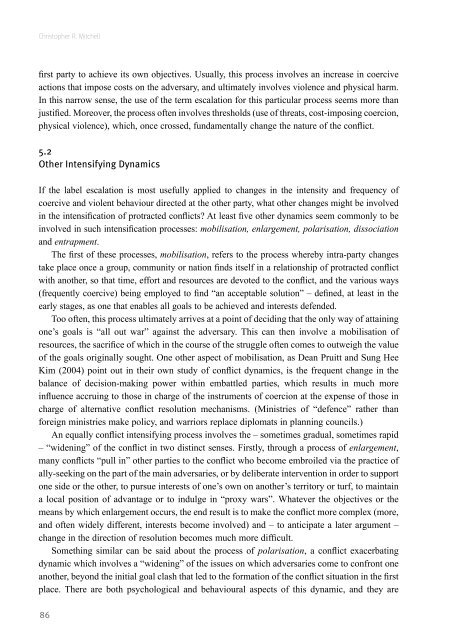Conflict, Change and Conflict Resolution - Berghof Handbook for ...
Conflict, Change and Conflict Resolution - Berghof Handbook for ...
Conflict, Change and Conflict Resolution - Berghof Handbook for ...
You also want an ePaper? Increase the reach of your titles
YUMPU automatically turns print PDFs into web optimized ePapers that Google loves.
Christopher R. Mitchell<br />
first party to achieve its own objectives. Usually, this process involves an increase in coercive<br />
actions that impose costs on the adversary, <strong>and</strong> ultimately involves violence <strong>and</strong> physical harm.<br />
In this narrow sense, the use of the term escalation <strong>for</strong> this particular process seems more than<br />
justified. Moreover, the process often involves thresholds (use of threats, cost-imposing coercion,<br />
physical violence), which, once crossed, fundamentally change the nature of the conflict.<br />
5.2<br />
Other Intensifying Dynamics<br />
If the label escalation is most usefully applied to changes in the intensity <strong>and</strong> frequency of<br />
coercive <strong>and</strong> violent behaviour directed at the other party, what other changes might be involved<br />
in the intensification of protracted conflicts? At least five other dynamics seem commonly to be<br />
involved in such intensification processes: mobilisation, enlargement, polarisation, dissociation<br />
<strong>and</strong> entrapment.<br />
The first of these processes, mobilisation, refers to the process whereby intra-party changes<br />
take place once a group, community or nation finds itself in a relationship of protracted conflict<br />
with another, so that time, ef<strong>for</strong>t <strong>and</strong> resources are devoted to the conflict, <strong>and</strong> the various ways<br />
(frequently coercive) being employed to find “an acceptable solution” – defined, at least in the<br />
early stages, as one that enables all goals to be achieved <strong>and</strong> interests defended.<br />
Too often, this process ultimately arrives at a point of deciding that the only way of attaining<br />
one’s goals is “all out war” against the adversary. This can then involve a mobilisation of<br />
resources, the sacrifice of which in the course of the struggle often comes to outweigh the value<br />
of the goals originally sought. One other aspect of mobilisation, as Dean Pruitt <strong>and</strong> Sung Hee<br />
Kim (2004) point out in their own study of conflict dynamics, is the frequent change in the<br />
balance of decision-making power within embattled parties, which results in much more<br />
influence accruing to those in charge of the instruments of coercion at the expense of those in<br />
charge of alternative conflict resolution mechanisms. (Ministries of “defence” rather than<br />
<strong>for</strong>eign ministries make policy, <strong>and</strong> warriors replace diplomats in planning councils.)<br />
An equally conflict intensifying process involves the – sometimes gradual, sometimes rapid<br />
– “widening” of the conflict in two distinct senses. Firstly, through a process of enlargement,<br />
many conflicts “pull in” other parties to the conflict who become embroiled via the practice of<br />
ally-seeking on the part of the main adversaries, or by deliberate intervention in order to support<br />
one side or the other, to pursue interests of one’s own on another’s territory or turf, to maintain<br />
a local position of advantage or to indulge in “proxy wars”. Whatever the objectives or the<br />
means by which enlargement occurs, the end result is to make the conflict more complex (more,<br />
<strong>and</strong> often widely different, interests become involved) <strong>and</strong> – to anticipate a later argument –<br />
change in the direction of resolution becomes much more difficult.<br />
Something similar can be said about the process of polarisation, a conflict exacerbating<br />
dynamic which involves a “widening” of the issues on which adversaries come to confront one<br />
another, beyond the initial goal clash that led to the <strong>for</strong>mation of the conflict situation in the first<br />
place. There are both psychological <strong>and</strong> behavioural aspects of this dynamic, <strong>and</strong> they are<br />
86
















